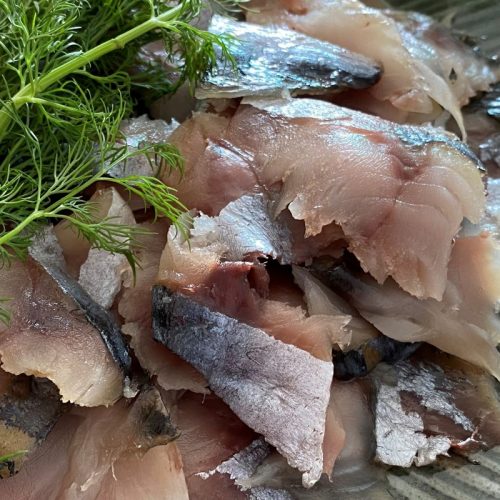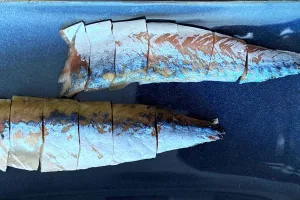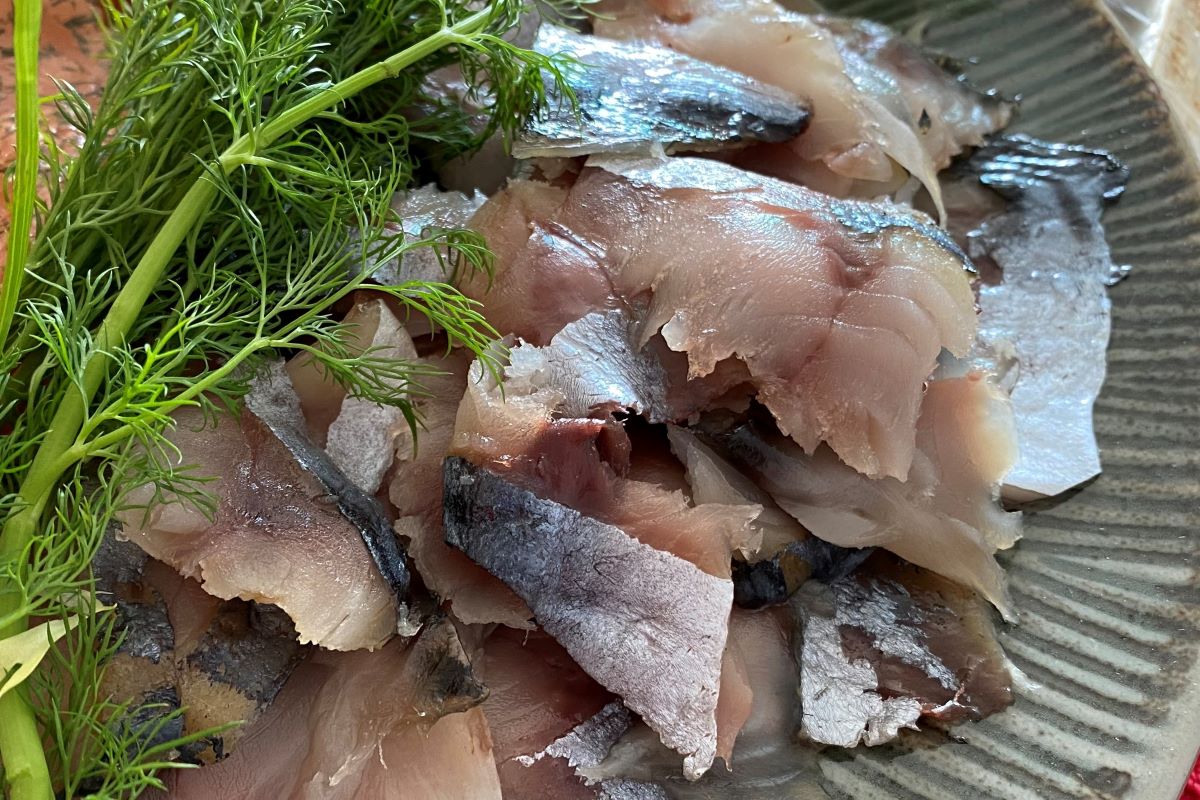Sugar cured mackerel is prepared in a somewhat similar way as gravad laks. This is the century old tradition in Scandinavia to bury a fresh, gutted salmon with salt, sugary berries and herbs. We apply some variations to make delicious mackerel. Serve it on blini, toast or with white bread.
The sugar and small amount of salt draw out water from the fish- and bacteria- cells, thus having a preserving effect on the fish. The cold storage conditions and the tightly packed fish halves will also prevent the fish oil become rancid. The preparation is not time consuming and only takes 2 full days.
While mackerel is one of the healthiest and cheapest fish to buy, many people are put off by the fishy taste. Following this simple recipe you will discover that it yields an uncooked, healthy fish with an incredible taste pallet.
The art of making sugar cured mackerel
As with all fish curing techniques, you need to work clean. Take the following operational procedures always in mind. 1. Fresh fish may contain parasites such as worms. Thus the safest way is to freeze the fish (halves) at -20 C for a week before using. 2. When handling fish make sure your boards and knifes are clean and free of odors. 3. Keep your fish in the fridge during the curing and also after. The colder, the better (but do not freeze).
In this recipe, you may compare the operation with making the pickled mackerel listed under food base essentials. In essence here we apply a much milder cure. Using diluted vinegar first, followed by a milder, but longer cure in sugar, salt, juniper berries and fresh dille.
I always start off with flash-frozen mackerel halves. This saves the parasite elimination step and ensures a safe transport home in a warm city.
After a full day of ‘curing’ I usually turn all halves around. Make sure you keep flesh on flesh and skin on skin. A weight is not really necessary here to help the fish bleed water. Without weight you will find the fish become more firm after 1 day.
For cleaning and cutting of the cured fish see remarks below and in the recipe.
The cured fish will keep for a few days in the fridge without any problem.
Special Equipment
- tweezers to remove skin and bones

Sugar cured mackerel
Equipment
- pair of tweezers
Ingredients
Ingredients for the dish
- 4 mackerel halves
- 17 oz (500 g) sugar
- 2 oz (55 g) sea salt
- big bunch fresh dill
- 25 juniper berries
- 2 oz rice vinegar or white vinegar
- 1 quart (1 L) water
Instructions
Instructions to make the dish
- On day 1, make a solution of 2 oz (60 ml) vinegar in 1 quart (1 L) of (purified) water and place this in a zip lock bag or other container.
- Rinse the frozen mackerel halves under cold water for a minute
- Place the half frozen mackerel halves in the dilute vinegar mixture so they are fully immersed and place in the fridge for minimum 12 h and maximum 24 h
- On day 2, prepare the sugar and salt mixture, wash the dill and dry them in a salad centrifuge or on paper towels. Crush the juniper berries with the flat part of your knife
- Rinse the vinegar treated mackerel halves under water and dry with a kitchen paper towel
- In an oblong bowl or container, spread a third of the sugar/salt mixture on the bottom. You can also use a zip lock bag.
- Place two fish halves skin side down and spread another third of the sugar salt mixture on the meat sides. Also place all dill and crushed juniper berries on the meat sides
- Then place the other two halves on top, flesh on flesh, so skin-side up and cover with the remaining sugar salt mixture
- Cover with kitchen wrap. Place in the refrigerator
- After 24 h, turn the fish upside down and let cure for another half day in the refrigerator
- After the curing, remove the fish halves and clean them from the curing mixture with a spoon. Optionally give them a quick rinse with water. Dry the cured halves.
- Thereafter, cut out the pectoral fin, that is mostly left on the fish behind the gill. Also check if there is any part where the dorsal fins or pelvic fins were attached that needs to be removed. Then remove the skin with your fingers or with a pair of tweezers.
- Remove the pin bones in the middle of the fish, thereafter the skeleton bones. Use your clean fingers to feel them out and use tweezers to take them out
- Finally use a very sharp knife to cut thin slices perpendicular to the length of the fish, but also in a diagonal fashion, thus making larger slices. You may prefer instead to cut thicker more regular slices. See next picture.
- Place the slices on a plate. Thereafter cover and refrigerate until use.

Notes
Food allergy & intolerance information: fish
Remarks
- You will find that the most of your ‘cooking’ time of the sugar cured mackerel will go into the final cleaning and de-boning of the cured mackerel halves. You might ask a fish monger to do it when you buy the fish fresh, but in most cases you will have to do this yourself. But with some experience it is only 5 minutes per mackerel half.
- The osmotic pressure of the sugar and the salt cause the fish to be partially dehydrated. That is why after 36 hrs in the curing mix, there is fluid visible. Also it firms up the flesh.
- The diluted vinegar bath on day one will ‘cook’ the fish surface superficially. It contributes to taking away the fishy smell.
- Curing the fish shorter will turn the taste more to fresh mackerel and curing it longer, will make the fish taste more dry.
- Finally, try to get your hands on mackerel that is caught in the fall, when they are fattest.



